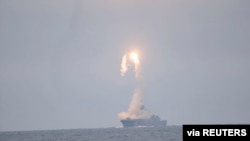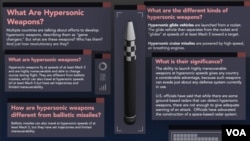Multiple countries are talking about efforts to develop hypersonic weapons, describing them as "game changers." But what are these weapons? Who has them? And just how revolutionary are they?
What are hypersonic weapons?
Hypersonic weapons fly at speeds of at least Mach 5 and are highly maneuverable and able to change course during flight. They are different from ballistic missiles, which can also travel at hypersonic speeds (of at least Mach 5) but have set trajectories and limited maneuverability.
What are the different kinds of hypersonic weapons?
There are two main categories of hypersonic weapons: hypersonic glide vehicles and hypersonic cruise missiles.
Hypersonic glide vehicles are launched from a rocket. The glide vehicle then separates from the rocket and “glides” at speeds of at least Mach 5 toward a target.
Hypersonic cruise missiles are powered by high-speed, air-breathing engines.
What is their significance?
The ability to launch highly maneuverable weapons at hypersonic speeds gives any country a considerable advantage, because such weapons can evade just about any defense system currently in use.
"It doesn't matter what the threat is. If you can't see it, you can't defend against it," General John Hyten, the former vice chairman of the U.S. Joint Chiefs of Staff, told an audience in Washington in January 2020.
As the commander of U.S. Strategic Command in 2018, Hyten said, “We don't have any defense that could deny the deployment of such a weapon against us. … Our defense is deterrent capability.”
U.S. officials have said that while there are some ground-based radars that can detect hypersonic weapons, there are not enough to give adequate warning of an attack. Officials, like the now-retired Hyten, have advocated the construction of a space-based radar system.
How are hypersonic weapons different from ballistic missiles?
Ballistic missiles can also travel at hypersonic speeds of at least Mach 5, but they have set trajectories and limited maneuverability.
What countries are developing hypersonic weapons?
The United States, Russia and China are all developing hypersonic weapons. Additional countries are conducting research on weapons, while others have made claims about testing hypersonic weapons that cannot yet be verified.
Here is a closer look at some of the countries developing these weapons:
United States
The U.S. military requested $3.8 billion for the development of hypersonic weapons for fiscal year 2022, and another $246.9 million for hypersonic defense research. Most U.S. hypersonic weapons are still in the development or testing phase, but at least one system is expected to reach early operational capability this year. U.S. hypersonic weapons are armed with conventional warheads.
Russia
Russia has been pursuing hypersonic weapon technology since the 1980s and in just the past several days has become the first nation to deploy hypersonic weapons in combat, launching at least one such missile against a target in Ukraine, according to a Western military official.
Russian military officials claimed on March 19 that they fired hypersonic missiles for the first time in Ukraine to target what they said was an underground weapons storage site in the west of the country.
On March 21, U.S. President Joe Biden confirmed Moscow’s use of a hypersonic missile, saying, “It's the only thing that they can get through with absolute certainty,” and further calling the use of the technology as “consequential.”
Russian officials say the hypersonic missile used in Ukraine was its Kinzhal model, which was launched from a military jet. Russia also boasts of having a hypersonic glide vehicle, the Avangard, and is developing the Tsirkon, a ship-launched hypersonic cruise missile.
Reports indicate the Avangard carries a nuclear warhead. Russian news outlets have further claimed the Avangard has been deployed in service since December 2019.
China
U.S. military and intelligence officials say China is pursuing hypersonic cruise missiles and hypersonic glide vehicles, and that at least one missile capable of carrying hypersonic glide vehicles may now be in use. The U.S. officials say Beijing has conducted “hundreds” of hypersonic weapons tests between 2016 and 2021, while Washington conducted only nine tests during the same period. General Mark Milley, U.S. chairman of the Joint Chiefs of Staff, described a high-profile Chinese hypersonic test carried out in August 2021 as “very significant.”
"We're witnessing one of the largest shifts in global geostrategic power … it only happens once in a while," Milley said.
North Korea
North Korea claims to have successfully test-fired two hypersonic missiles so far this year — one on January 5, and the latest on January 11, according to state-run Korea Central News Agency. U.S. officials have so far not confirmed the claims, describing the launches only as ballistic missile tests. North Korean leader Kim Jong Un has said hypersonic missiles would greatly increase his country’s nuclear “war deterrent,” a position that many experts say puts South Korea at risk.
Other countries
Australia, India, France, Germany and Japan are developing hypersonic weapon technology. Iran, Israel and South Korea are also reported to have done what has been described as “foundational research” on hypersonic weapons.
Sources: Congressional Research Service, VOA reporting







